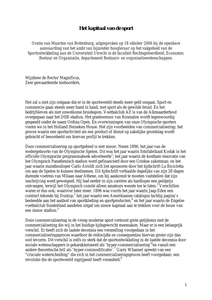Worldwide, rivers face challenges due to human and climatic pressures. Floods, droughts, pollution, damming and hydropeaking are only a few examples of these pressures, and influence the way rivers flow. Climate change adaptation projects increase the incentive to domesticate rivers, often legitimised through expert views on (future) vulnerability and risk. This emerging river imaginary dominates current debates in many rivers in our world. River imaginaries reflect spatially bound hydrosocial territories in which multiple actors on multiple scales from multiples sectors operate to reach varying objectives. They include water flows, ecological systems, climate conditions, hydraulic infrastructure, financial means, institutional arrangements, legal frameworks and information/knowledge hubs. In the context of climate change adaptation, river imaginaries are strongly dependent on the extent to which climate change is expected to influence rivers through a mixture of probable, possible, desirable or preferable versions of a (future) river. As such, knowledge-structures of future making are scrutinised in this research by emphasising on the role of change, the role of futures and the role of experts. This presentation aims to elucidate how river imaginaries have influenced river management under climate change adaptation that resulted in large infrastructural projects. Through a study of the Meuse river, a concrete case of a imaginary came into being in the Dutch-Belgian Border-Meuse trajectory. Moreover, preliminary result from adaptation projects in the marshlands of the lower Magdalena in Colombia strengthen the dominate imaginary of technocratic and ecocentric approaches to climate change adaptation where an expert view on local knowledge dominates.
DOCUMENT
Oratie over het commercialiseringsproces op sportgebied, uitgesproken op 18 oktober 2006 bij de openbare aanvaarding van het ambt van bijzonder hoogleraar op het vakgebied van de Sportontwikkeling aan de Universiteit Utrecht in de faculteit Rechtsgeleerdheid, Economie, Bestuur en Organisatie, departement Bestuurs- en organisatiewetenschappen.
DOCUMENT

In deze rapportage worden de bevindingen gepresenteerd van een studie naar de huidige en toekomstige focus van de toeristisch-recreatieve beleidskaders en samenwerkingsmogelijkheden van Emsland-Drenthe.
DOCUMENT

Over the last two decades, institutions for higher education such as universities and colleges have rapidly expanded and as a result have experienced profound changes in processes of research and organization. However, the rapid expansion and change has fuelled concerns about issues such as educators' technology professional development. Despite the educational value of emerging technologies in schools, the introduction has not yet enjoyed much success. Effective use of information and communication technologies requires a substantial change in pedagogical practice. Traditional training and learning approaches cannot cope with the rising demand on educators to make use of innovative technologies in their teaching. As a result, educational institutions as well as the public are more and more aware of the need for adequate technology professional development. The focus of this paper is to look at action research as a qualitative research methodology for studying technology professional development in HE in order to improve teaching and learning with ICTs at the tertiary level. The data discussed in this paper have been drawn from a cross institutional setting at Fontys University of Applied Sciences, The Netherlands. The data were collected and analysed according to a qualitative approach.
DOCUMENT

We need mental and physical reference points. We need physical reference points such as signposts to show us which way to go, for example to the airport or the hospital, and we need reference points to show us where we are. Why? If you don’t know where you are, it’s quite a difficult job to find your way, thus landmarks and “lieux de memoire” play an important role in our lives.
LINK
Pressure on natural resources, unsustainable production and consumption, inequality and a growing global population lie at the base of the big challenges that people face. This chapter investigates how businesses can take responsibility in dealing with these challenges by means of frugal business model innovation. The notion of ‘frugal innovation’ was first introduced in the context of emerging markets, giving non-affluent customers opportunities to consume affordable products and services suited to their needs. Business modelling with a frugal mindset opens up a path that provides significant value while minimizing the use of resources such as energy, capital and time. Business models require intentional design if they are to deliver aspired sustainability impacts. Diminish or simplify resources can be described as the means to remove or reduce features, resources, required activities and/or waste streams. Decompose can be described as the removal of resources from the commercial value proposition and replacing them with resources the user/consumer already can access or uses. This is an Accepted Manuscript of a book chapter published by Routledge/CRC Press in Circular Economy : Challenges and Opportunities for Ethical and Sustainable Business on 2021, available online: https://doi.org/10.4324/9780367816650
DOCUMENT

This chapter will introduce the circular economy (CE) and Cradle to Cradle (C2C) models of sustainable production. It will reflect on the key blockages to a meaningful sustainable production and how these could be overcome, particularly in the context of business education. The case study of the course for bachelor’s students within International Business Management Studies (IBMS), and at University College in The Netherlands will be discussed. These case studies will illustrate the opportunities as well as potential pitfalls of the closed loop production models. The results of case studies’ analysis show that there was a mismatch between expectations of the sponsor companies and those of students on the one hand and a mismatch between theory and practice on the other hand. Helpful directions for future research and teaching practice are outlined. https://www.springer.com/gp/book/9783319713113#aboutBook https://www.linkedin.com/in/helenkopnina/
MULTIFILE
